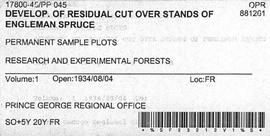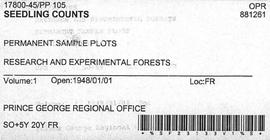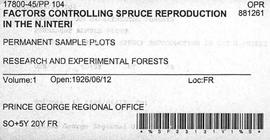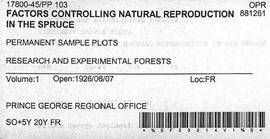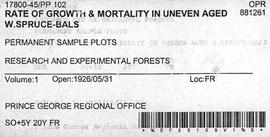Item is a copy of "Review of Cutting Practices in the Spruce-Balsam Stands" in the Prince George Forest District.
File is a Resource Folio of maps and accompanying information created by Northwood Pulp & Timber regarding Timber Sale Harvesting Licence A01847, Willow River Block, Willow River P.S.Y.U. Includes maps that depict ungulates, waterfowl, recreation areas, special influence areas, and timber types. Most of the sheets have a duplicate, some with very slight variations. The following maps are supposed to be included in the but were missing upon arrival at the Archives: fish & topography, cutting permits & roads, and soils.
Item is a draft of "Resource Analysis 1984, Project No. 26, Silvicultural Systems" by J. Revel.
Item is a photocopied "Report on Mt. Edziza, Tatlatui, Spatsizi" by Bob Henderson.
In the mid-1990s, Dr. Paul Sanborn worked with Dr. Lito Arocena of UNBC to assemble and interpret basic physical, chemical, and mineralogical data for typical soils at important long-term forestry research sites in central and northeastern BC. The key results were published as:
J.M. Arocena and P. Sanborn. 1999. Mineralogy and genesis of selected soils and their implications for forest management in central and northeastern British Columbia. Canadian Journal of Soil Science 79: 571-592. https://doi.org/10.4141/S98-07
Nine pedons were involved, with 7 located at the sites of 4 Ministry of Forests Experimental Projects (E.P.), and 2 at the Aleza Lake Research Forest.
Item is an original draft copy of "Regional Landscapes for the British Columbia Parks System".
Item is an original report by H.M. Pogue titled "Regeneration and Growth of White Spruce After Logging".
Item is a photocopy of "Provincial Parks and Stone Sheep: 'Affinity Through Default'" report by W.G. Hazelwood, Parks Biologist.
During a year away from studies in 1987-88, Dr. Paul Sanborn developed a successful grant proposal to the Science Council of BC (SCBC) to pursue a postdoctoral project with Dr. Tim Ballard in relation to sulphur-deficient soils in BC and prescribed fire. This project built on an existing broadcast burning study conducted by Macmillan Bloedel Ltd. near Port Alberni on Vancouver Island, led by Bill Beese (later at Vancouver Island University). Dr. Sanborn's work addressed sulphur forms and amounts in the soils at these sites, and the chemical processes influencing sulphur availability in relation to prescribed fire.
Only one part of this work was eventually published:
Sanborn, P.T. and T.M. Ballard. 1991. Combustion losses of sulphur from conifer foliage: Implications of chemical form and soil nitrogen status. Biogeochemistry 12: 129–134.
https://doi.org/10.1007/BF00001810
The remainder of the work was documented in this Project Completion Report to SCBC, dated February 28, 1990, and entitled "Effects of Prescribed Fire on Sulphur in Forest Soils".
This born-digital "Profile Descriptions" document provides descriptions of Williams Lake (Skulow Lake), Aleza 1 & 2, Log Lake, and Lucille Mountain pedons.
Item is an original BC Parks report entitled "Preservation and Management of the Grizzly Bear in B.C. Provincial Parks: The Urgent Challenge".
Item is an original wildlife section report by R.W. Ritcey entitled "Predators in Wells Gray Park 1950-1956".
File contains a report, working copies of charts, and handwritten ledger pages of Plot 50.
File contains a report, germination summaries, photocopies of permanent sample plot data charts, photocopies of logging inspection reports, maps, timber sales contracts, and related correspondence pertaining to Plot 45.
File contains loose handwritten ledger pages, a photocopy of the original report, photocopied handwritten notes, and data report sheets for Plot 292.
File contains photocopied working copy of data listings, loose handwritten ledger pages, and a photocopy of the original study for Plot 291.
File contains original studies, and black and white photos for Plot 104.
File contains handwritten cross section book, original studies with handwritten measurement charts and black and white photos, loose pages of original correspondence, handwritten diagrams and measurement charts, loose handwritten tally sheets, black and white photographs, hand coloured plot diagrams, photocopies of aerial photographs, and original correspondence for Plot 160.
File contains photocopy of related study, photocopied handwritten notes, loose handwritten ledger pages, and working copies of photocopied data report listings for Plot 150.
File contains photocopied related report, loose handwritten ledger pages, and photocopies of handwritten notes and data listing reports for Plot 149.
File contains photocopied report, loose handwritten ledger pages, photocopies of handwritten notes and data listing reports for Plot 148.
File contains original loose handwritten ledger pages and data charts, and the original related reports for Plot 120.
File contains photocopied and handwritten data listing reports, and a photocopy of the related study for Plot 119.
File contains handwritten and photocopies of measurement charts, and a photocopy of the the related study for Plot 118.
File contains photocopied data report and measurements, and handwritten tables and graphs.
File contains photocopies of measurement charts, and the report for Plot 115.
File contains original handwritten notes and photocopied data listing reports for Plot 116.
File contains handwritten measurements and charts for Plot 114.
File contains photocopies of original study, loose handwritten ledger notes, and measurement charts relating to Plots 112 and 113.
File contains handwritten germination summaries and measurements, charts, and the original study relating to Plot 111.
File contains handwritten notes, original diagrams, charts, studies, and black and white photos relating to Plot 108.
File contains photocopied study, handwritten loose ledger pages, and photocopied data sheets for plot 107.
File contains photocopies of data sheets and charts, handwritten ledger pages, and a photocopied study of plot 106.
File contains original study, charts, and measurements of plot 105.
File contains original study, measurements, and charts of plot 104.
File contains photocopied measurement tables, handwritten ledger pages, and a photocopied report for plot 103.
File contains original study data for Plot 102, and includes handwritten charts, tables and diagrams.
The Lost Chicken Mine, a placer gold mine in eastern Alaska, approximately 120 km west of Dawson City, Yukon, is an important fossil locality for the late Pliocene (approximately 2.5 – 3.0 million years ago). A comprehensive account of the stratigraphy and paleontology of this site was given by:
Matthews, J.V., Jr., J.A. Westgate, L. Ovenden, L.D. Carter, and T. Fouch. 2003. Stratigraphy, fossils, and age of sediments at the upper pit of the Lost Chicken gold mine: new information on the late Pliocene environment of east central Alaska. Quaternary Research 60: 9-18. https://doi.org/10.1016/S0033-5894(03)00087-5
Dr. Paul Sanborn visited the site on July 20, 2004, as part of a group led by Duane Froese (Professor, University of Alberta). The group concentrated on a single exposure (~ 2 m thick) straddling the Lost Chicken tephra, a volcanic ash bed (2.9 ± 0.4 myr) which is a major stratigraphic marker at the site. Sanborn described, photographed, and sampled this exposure, and obtained a basic set of characterization data. Intact samples were collected but thin sections were never produced.
As part of a multidisciplinary team led by Grant Zazula (then a Ph.D. student at Simon Fraser University; later a palaeontologist with the Government of Yukon) and Duane Froese (Professor, University of Alberta), Dr. Paul Sanborn examined a set of buried paleosols (fossil soils) preserved in frozen sediments exposed by placer mining in the spring of 2004.
The findings were published in:
Zazula, G.D., D.G. Froese, S.A. Elias, S. Kuzmina, C. La Farge, A.V. Reyes, P.T. Sanborn, C.E. Schweger, C.A.S. Smith, and R.W. Mathewes. 2006. Vegetation buried under Dawson tephra (25,300 14C yr BP) and locally diverse late Pleistocene paleoenvironments of Goldbottom Creek, Yukon, Canada. Palaeogeography, Palaeoclimatology, Palaeoecology 242: 253–286.
https://doi.org/10.1016/j.palaeo.2006.06.005
This born-digital document is an unpublished report to the Geological Survey of Canada on field work data and interpretations of Inlin Brook paleosols.
File contains 1998 proposals and other correspondence between the Ministry of Forests and the Aleza Lake Steering Committee regarding the future management of the Aleza Lake Research Forest.
Item is a photocopied report by Don Miller entitled "Observations of Caribou and Caribou Environment in Northern and Southern Tweedsmuir Park and Wells Gray Park in Summer of 1977 with Comments on Related Observations in Spatsizi Park during Spring".
Item is an original "Northern Interior Forest Experiment Station: Report of Preliminary Investigations" by Percy Barr. Includes original photographic prints.
Item is a poorly photocopied version of Percy Barr's "Northern Interior Forest Experiment Station Progress Report". Location of original is unknown.
Item is a photocopied excerpt from an issue of "The Forestry Chronicle" entitled "Natural Reproduction Following Fires in Central British Columbia" by E.H. Garman.
Item is an original report by Grant Hazelwood entitled "Mt. Assiniboine Park Trip, August 19-22, 1974". Includes original print photographs pasted into the report. The objective was to sample the lakes fishery at the south and north ends of the park and to examine some grizzly bear habitat on the Simpson River and examine the condition of guiding cabins in the same area.
Item is a photocopied "Mountain Goat Surveys in the Tatlatui, Spatsizi and Mt. Edziza Provincial Park Areas, British Columbia" report by David F. Hatler (Wildeor) and W.G. Hazelwood (Alpenglow Resources).
Item is an original "Mount Edziza Park Wildlife Report: An Argument for Nature Conservancy Status" report by W.G. Hazelwood, Parks Biologist. Includes original photographic prints pasted into the report. Also includes an accompanying "Mt. Edziza Wildlife Survey" from October 13, 1979.
Document prepared by P. Grilz contains species lists and UTM coordinates for 10 sampling locations for the M-K-2001-2002-81 Seed Project.
